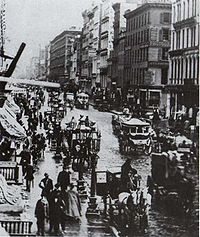Far away from the battlefields and the contraband camps in which many New Yorkers serve the cause of freedom for all, open space in New York City is becoming all the more rare. The growth in the density of New York City is now impacting the Madison Avenue Baptist Church, a congregation seeking to make better use of its church grounds. Standing in the way is that which has been a staple of many church yards since early colonial days: the church graveyard.
The City Inspector has granted a special permit to the trustees of the Madison-avenue Baptist Church to remove the bodies in the burying-ground on the corner of Amity and Wooster streets to the Cypress Hills Cemetery. Mr. WILLIAM H. BURGER, a deacon of the church, will personally superintend the removal, and the friends of deceased must remove the stones and monuments before the 16th inst., when the removals will begin.
The burying-ground in question is but a small one, and has been for years closely fenced in on the Amity and Wooster street sides, while it is bounded on the east by Rev. Dr. WILLIAMS’ Baptist Church, and on the north by private dwellings. It is but a stone’s throw from the old Potter’s Field — now Washington Parade Ground.
Church graveyards in northeastern cities from here forward experience a declining presence against the backdrop of ever-growing urbanization.
In addition, during the war the deaths of hundreds of thousands of soldiers leads to the creation of massive graveyards in the proximity of the battles, most of which are fought in rural areas. Death itself, in the public imagination, displayed so vividly on a massive scale unprecedented in American history, is elevated to a new level in American life. To this day, some of the nation’s Civil War graveyards remain among the most hallowed places on American soil, sacred ground preserved from the modern encroachments of ever-expanding urbanization.
Source: “Local Intelligence,” New York Times, February 16, 1863 (link )



